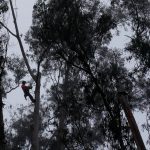In the coming months, drivers in San Benito County will face a traffic pattern unlike anything else in the state: a three-lane rotary shaped like a stunted ninja star. This is only the second time the new design, called a turbo roundabout, is being implemented in the U.S. But if it meets its goal of reducing accidents at a crossroads with a history of harmful crashes, drivers across the country could be seeing more of them.
The intersection of Highways 25 and 156 in Hollister has been notoriously dangerous — the site of more than twice as many accidents as similar intersections in the state, resulting in multiple injuries. In particular, there have been an unusual number of rear-impact and T-bone collisions there.
Caltrans had previously attempted several small fixes, such as changing the timing on the traffic signals and adding rumble strips going up to the signal. But after these failed to resolve the problems, the agency opted to create a special roundabout.
Caltrans is constructing a new “Turbo Roundabout” at the intersection of highways 25 and 156,in Gilroy, Calif., on Friday, Dec. 29, 2023. (Shae Hammond/Bay Area News Group)
For high-speed rural intersections similar to the one in Hollister, roundabouts can lead to an over 60% reduction in crashes, according to statistics compiled by the Insurance Institute for Highway Safety.
“In every location where we have installed a roundabout, we have seen a decrease in traffic incidents,” said Jim Shivers, a spokesperson for Caltrans District 5, which includes the county. “They’ve been a very successful thing that we have in the Caltrans toolbox.”
However, multilane roundabouts can still create issues if drivers shift lanes while in them — problems that Caltrans hopes the new turbo roundabout will eliminate. It includes extra features to prevent drivers from changing lanes while going through the intersection; approaching drivers choose their lane before entering the roundabout, and follow overhead signage that shows which lane leads to which exit.
The state’s first turbo roundabout will feature three lanes wide enough to accommodate semi-trucks, which are separated by raised dividers that keep drivers in their lanes.
Turbo roundabouts were first developed in the Netherlands in 1996, but have since spread around the world, though most are in Europe. Studies in the Netherlands showed that the design advancements increased traffic capacity while reducing crashes by over 70% compared to traditional roundabouts.
The new roundabout design first came to the U.S. last year, when Jacksonville, Florida, installed one to help improve safety for cyclists and pedestrians.
Construction of the turbo roundabout in San Benito County will be completed in January, at a cost of $11.1 million, funded by the State Highway Operation and Protection Program. Given the novelty, Caltrans has released educational videos in English and Spanish explaining how to use the new intersection.
Related Articles
BART train derails near Orinda, injuring nine, forcing station closures and delays
Eastbound El Camino Real to be closed for weeks following Christmas Day blaze
Two youths killed in East Bay late night hit-and-run identified
Fiery crash is second fatal one in Antioch in less than a week
Mountain View: Two teens suffer major injuries after car crashes into tree
When the project was first proposed, some residents feared that the new traffic flow would result in confusion, and petitioned members of Congress and state legislators for an interchange or an overpass instead. However, as the turbo roundabout is under construction, a temporary one-lane roundabout is being used, and “residents have been quite pleased” with the result, said Veronica Lezama, transportation planning manager for San Benito County’s Council of Governments.
The long-term plan is to install an interchange with ramps between the two highways at the location, Lezama said. But for the coming years, the roundabout will serve as a way to immediately address the safety needs of the intersection. According to data from the California Highway Patrol, of the 83 crashes that took place near there since January 2021, only three have taken place since the implementation of the one-lane roundabout in August — none of which have resulted in injuries.
“There typically is a learning curve,” Shivers said. However, he has confidence that the public will catch on and enjoy the benefits once the project is complete. “In all of these locations where we have installed (roundabouts), the concerns grind to a stop, because they find that the roundabout works. It does make life easier. It does increase safety for the public.”


